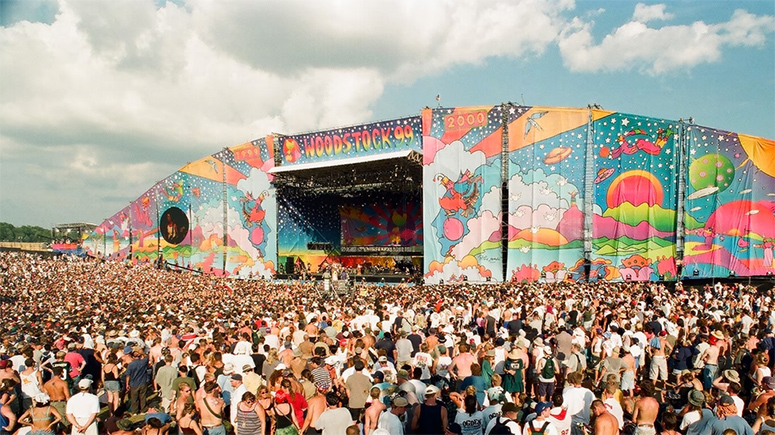Lollapalooza of the flies
We know that at least one of the people shown in the documentary Woodstock 99: Peace, Love, and Rage — about the disastrous 1999 cash-grab revival of the ’60s music festival that ended in a riot and flames — later became a Donald Trump fan: that would be Kid Rock.
Mr. Rock (or is it just “Kid”?) was known as one of the few musical acts willing to play at Trump rallies and inauguration events and occasionally would gamely appear alongside the Red-Tied One in the Oval Office for photo ops.
Kid Rock’s ribs shack in Nashville even played a cameo in the Jan. 6, 2021 Capitol Hill Riot, in which one of the participants, the guy sporting zip ties restraints and ninja gear and later arrested, was reportedly a disgruntled ex-employee of Kid Rock’s Big Ass Honky Tonk & Steakhouse.

Why does this matter? Well, it’s hard to watch Woodstock 99 without thinking about the level of white male rage coursing through America in the ‘90s (Why was it like this again? Who knows?) and how it metastasized to the levels of white male grievance that would propel Trump into office almost two decades later.
But for a depiction of how quickly a generation can degenerate into ‘Lord of the Flies,’ Woodstock 99 is a pretty good sociological document.
Everything about this Woodstock reboot sucked. From the choice of sticking the venue inside a metal-fenced military base, to the rampant capitalism of charging $4 for bottled water, to the tragic Portalet and shower situation, to the sight of Kid Rock strutting onstage in a white fur coat, like some mad pimp daddy. Oh, the horror! Oh, the suck!
That’s not even mentioning the music, which included only three female acts (count ‘em: Sheryl Crow, Alanis Morissette, Jewel) among a sea of lousy nu metal and angst rock acts like Live, Bush, Creed, Korn and Limp Bizkit, aimed at a squarely misogynistic crowd of backward-baseball cap-wearing douchebags who kept screaming “Show us your t*ts!” throughout the three days of peace, grope and shove.
The HBO film attempts to find reasons behind the disaster, but you maybe have to start with a moment in American history in which Girls Gone Wild was a cultural phenomenon, Napster was big, and Y2K occupied the youth consciousness. Smash and grab was already poised for a big comeback.
Of course, this white male rage would later mutate into racist rage (“White lives matter!”) and even more misogyny under an orange-haired would-be Mussolini in the White House. But for a depiction of how quickly a generation can degenerate into “Lord of the Flies,” Woodstock 99 is a pretty good sociological document.
Many rapes were reported (every time a female’s shirt came off, seemingly to appease lunk-headed male attendees, it seemed to spark a wave of grab and assault), death from hyperthermia — overheating in the August sun — and a full-scale burn-the-place-down riot at the end, accompanied by the Red Hot Chili Peppers unwisely launching into a cover of Hendrix’s Fire onstage, ending this crapfest on a note of misery and horror.

We can debate the relative value of some musical acts here — Rage Against the Machine certainly tried to point up racial tensions and social protest in their music — but when your headliner is an asinine cartoon named Fred Durst (from Limp Bizkit) leading a crowd to chant “Break stuff!” you can’t really point a finger anywhere else but the general cretin levels of ‘90s metal-rap and male-agro rock.
Watching the mindlessness take over, seemingly poised to infect a whole generation, one can only shake one’s head and whisper Kurtz’s words at the end of Heart of Darkness: “Exterminate the brutes!”
“Woodstock 99: Peace, Love and Rage” is shown on HBO Max.


